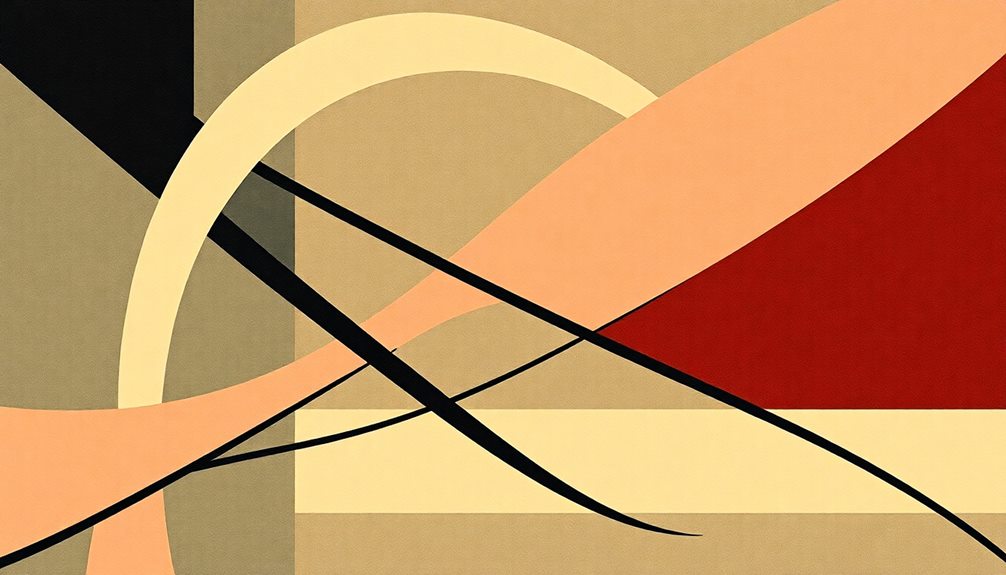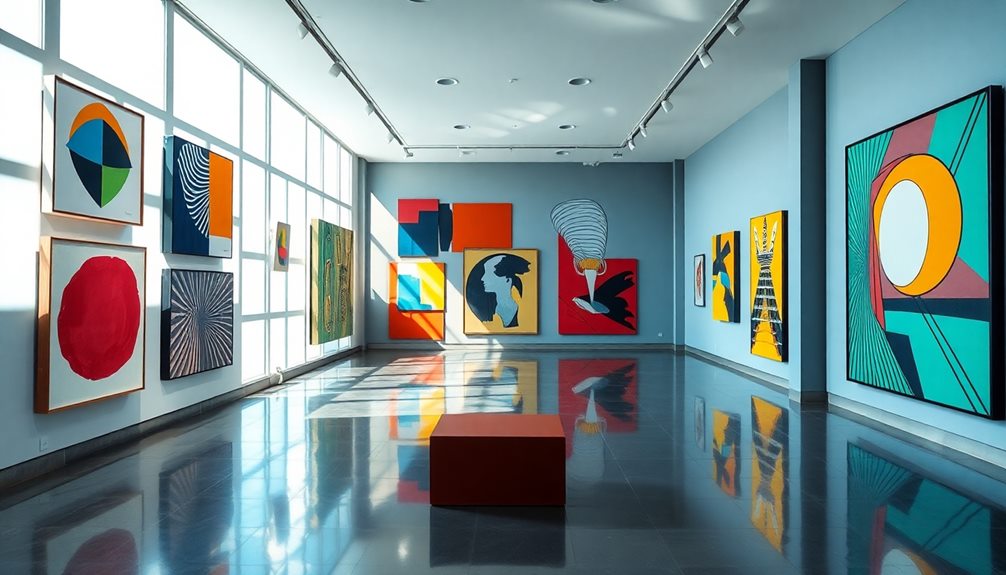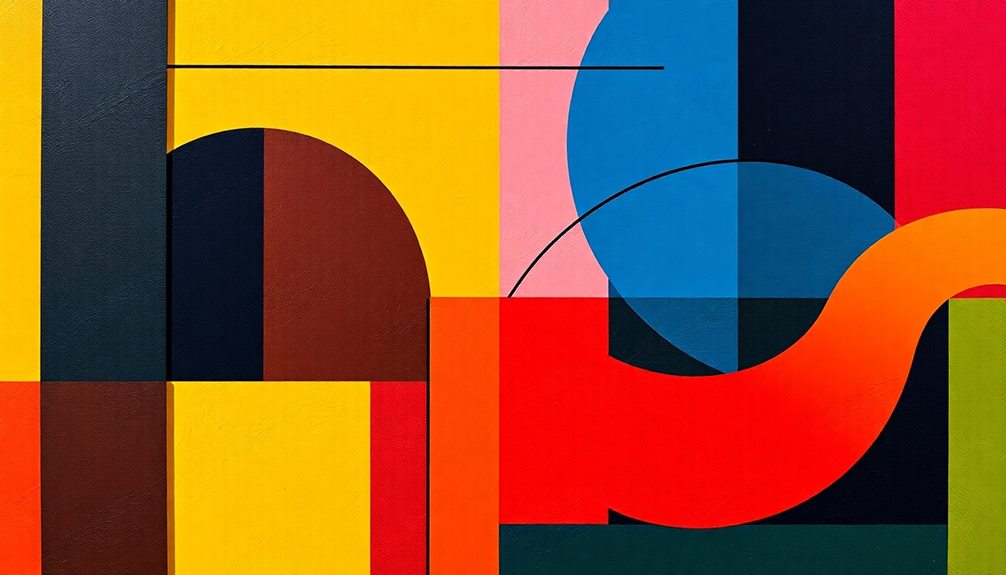Understanding line and form in formalist art helps you appreciate how these elements influence your perception and emotional engagement with an artwork. Lines guide your eye, conveying movement or stability, while shapes create a fundamental base and forms add depth. The balance between positive and negative space enriches your visual experience. Color evokes specific feelings, and texture invites your tactile imagination. By focusing on these intrinsic qualities rather than narrative elements, you can enhance your appreciation of art. If you explore further, you might uncover even more insights into the transformative power of line and form in art.
Key Takeaways
- Formalist art prioritizes intrinsic qualities like line, shape, color, space, and texture over narrative context, enhancing visual appreciation.
- Lines vary in width and direction, influencing perception of movement, stability, and emotional responses in artwork.
- Shapes are two-dimensional, while forms represent three-dimensional structures, with geometric shapes offering order and organic shapes providing fluidity.
- Positive and negative space interact to create depth; balance between them is crucial for visual impact and engagement.
- Color characteristics, including hue, value, and intensity, significantly affect emotional responses and the overall atmosphere of the artwork.
Introduction

In the realm of formalist art, understanding line and form is essential for grasping how artists communicate their vision. Line serves as a fundamental element, defining edges and outlines that guide your perception of movement and stability within a composition.
You'll notice how shapes, created by lines, form the two-dimensional basis of any artwork, while forms introduce three-dimensionality, adding depth and volume to the expression.
When you look closely, the interplay between positive and negative space becomes evident, shaping your understanding of how the subject relates to its surroundings. This relationship is crucial for creating depth and visual interest, drawing you into the piece.
Color also plays a significant role in formalism; hues, values, and intensities directly affect your emotional response and set the overall atmosphere.
As you explore these elements, consider how texture, whether actual or implied, enhances your engagement with the artwork. It describes the surface quality and informs your tactile experience, making the visual interaction richer.
Key Concepts and Definitions

Understanding the key concepts and definitions in formalist art is crucial for appreciating its nuances. Lines serve as the backbone of this art form, defining the edges and shapes of forms. They vary in width, direction, and length, conveying different emotions and spatial relationships.
Shapes, being two-dimensional, come to life through these lines, while forms represent three-dimensional structures that encompass height, width, and depth—essential in sculptures and decorative arts.
The interplay between positive space, occupied by primary objects, and negative space, the surrounding area, significantly affects the overall impact of a composition. This balance helps create a dynamic visual relationship that draws you in.
Color plays a vital role too; characterized by hue, value, and intensity, it shapes your emotional response and mood toward the artwork, influencing your perception.
Lastly, texture refers to the surface quality of an artwork. Whether physically felt or visually implied, texture enhances realism and engages you further through effective portrayal techniques.
Essential Elements of Formalism

The core components of formalism focus on the intrinsic qualities of art that shape its visual experience. In formalist art, line, shape, and color take center stage, steering your attention away from narrative context.
Lines define the edges of forms and can evoke various emotions; for instance, horizontal lines often suggest stability, while vertical lines convey height and aspiration.
Shapes, the two-dimensional elements created by lines, can be geometric or organic. Geometric shapes represent man-made structures, while organic shapes mimic the natural world. Understanding these shapes helps you appreciate how they interact within the composition, where the balance of positive and negative space significantly influences visual impact.
Color also plays a crucial role in formalism. It encompasses hue, value, and intensity, each element working together to evoke emotional responses and set the mood of the artwork.
Notable Formalist Artworks

Exploring notable formalist artworks reveals how artists skillfully manipulate elements like line, shape, and color to create powerful visual experiences.
Take Piet Mondrian's "Composition with Red, Blue, and Yellow"; it exemplifies the use of geometric shapes and primary colors, creating a sense of balance and harmony that resonates with viewers.
Similarly, Wassily Kandinsky's "Composition VII" dives deep into the relationships between color and form, showcasing the emotional impact of abstract composition.
Henri Matisse's "The Dance" captures dynamic lines and vibrant colors, emphasizing the expressive potential of form and movement in formalist art.
In contrast, Jackson Pollock's "No. 5, 1948" highlights the act of painting itself through drip techniques, focusing on line and texture instead of representational imagery—an essential characteristic of Abstract Expressionism.
Lastly, Donald Judd's "Untitled (Stack)" reflects a minimalist approach that underscores clean lines and geometric shapes, stripping away narrative elements to focus on the intrinsic qualities of materials.
Each of these notable formalist artworks demonstrates how the manipulation of formal elements can serve as powerful vehicles for artistic expression in modern art.
Tips and Best Practices

When analyzing formalist art, applying specific tips and best practices can deepen your understanding and appreciation.
Start by examining the lines used in the artwork. Note that horizontal lines often suggest calmness, while diagonal lines can imply movement and tension. This distinction can provide insight into the artwork's overall mood.
Next, pay attention to the geometric shapes present. Recognize how these precise, structured forms differ from organic shapes, which are more fluid and natural. This contrast contributes significantly to the composition.
Also, consider the arrangement of positive and negative space. This interplay creates depth and guides your eye throughout the piece, enhancing your viewing experience.
Don't overlook color, either. Observe the hues, values, and intensities, as they can dramatically affect your emotional response. Different color choices can evoke varying moods, making this aspect crucial for analysis.
Audience's Emotional Engagement

Engaging with Formalist art can be a deeply emotional experience, as its power lies in the visual elements rather than any narrative. The audience's emotional engagement is intricately tied to how you perceive lines, shapes, and colors.
For instance, vertical lines might evoke feelings of spirituality or aspiration, while diagonal lines can create tension or a sense of movement.
Color plays a critical role in shaping your emotional response. Warm colors often energize, making you feel vibrant and alive, whereas cool colors provide a calming effect, inviting you to relax.
Similarly, the shapes you encounter guide your perception; geometric forms may instill a sense of order and stability, while organic shapes can stir more emotional, instinctive reactions.
Ultimately, Formalism champions these intrinsic qualities of the artwork itself. When you focus on the visual elements, you allow yourself to engage emotionally with the piece, appreciating the beauty of lines, shapes, and colors without the distraction of external storytelling.
This pure interaction fosters a unique connection, enabling you to experience art in a profoundly personal way.
Artistic Medium Limitations

The choice of artistic medium plays a crucial role in shaping the expression of line and form in formalist art. Different materials, like oil, acrylic, or watercolor, yield unique textures and visual qualities that influence your artwork. For example, oils offer smoother blending and richer color depths, allowing you to create bold lines and dynamic forms.
In contrast, watercolors impose transparency and fluidity, which can affect how those lines and forms are perceived in your composition.
Limitations inherent in your chosen medium can also restrict the range of lines and forms you can effectively utilize. If you're working on a large canvas, you might embrace expansive forms and bold lines, but smaller pieces may require a focus on precision and detail.
This can challenge your approach to composition and overall aesthetic appeal.
Additional Resources

Exploring line and form in formalist art can be enriched by utilizing various resources that deepen your understanding and enhance your practice. Start by delving into books and articles focused on the roles of lines and shapes in art.
Look for resources that explain how horizontal lines suggest stability, while vertical lines evoke spirituality, and diagonal lines convey movement.
You should also study the distinctions between geometric and organic shapes, as these impact your artwork's composition. Online courses can provide hands-on experience with color theory, emphasizing how hue, value, and intensity influence emotional responses.
Don't overlook the importance of space; understanding the balance between positive and negative spaces will allow you to create depth in your pieces.
Engaging with visual and physical texture is crucial, so seek out materials that illustrate how texture can enhance realism and viewer engagement.
Exhibitions and workshops can offer you firsthand experience with these concepts in action.
Frequently Asked Questions
What Is Line and Form in Art?
In art, line defines edges and guides your eye, while form adds depth and dimension. You can see how lines suggest movement or stability, and forms create a sense of volume and presence in your artwork.
What Is Form in Formalist?
Form in formalist art refers to the physical shapes and structures you see in a piece. It emphasizes how these elements interact visually, creating balance and harmony without relying on narrative or context. Formalist art focuses on the arrangement of line, color, texture, and spatial relationships, allowing viewers to engage with the work on a purely aesthetic level. The role of composition in formalism is central, as it dictates how these elements are organized to evoke a sense of order and coherence. By prioritizing the visual experience over symbolism or storytelling, formalism challenges audiences to appreciate art as a self-contained, deliberate structure.
What Is the Definition of Line in Formal Elements of Art?
Line in the formal elements of art refers to a continuous mark made on a surface. It can vary in width, direction, and length, shaping how you perceive and connect with the artwork's overall composition.
What Are the Elements of Formalism in Art?
In art, formalism emphasizes elements like line, shape, color, texture, and form. You'll notice how these components interact, creating emotional depth and visual impact without relying on narrative or contextual elements to convey meaning.
Conclusion
In understanding line and form in formalist art, you'll discover how these elements shape your perception and appreciation of the artwork. By exploring key concepts, notable pieces, and practical tips, you can deepen your emotional engagement and refine your artistic eye. Remember, every line and form tells a story, inviting you to experience art in a new light. Dive into this fascinating world, and let your creativity thrive!









